Module 8: Stacks, Queues, ADT's
Supplemental material
Stacks: a simple example
What is a stack?
- You always add items to the front (top)
- You always remove items from the front (top)
=> you remove the most recently inserted item.
Here's a simple example we saw earlier in the Introduction:
import java.util.*;
public class StackExample {
public static void main (String[] argv)
{
// Use java.util.Stack, and specialize it to String's.
Stack<String> toDoList = new Stack<String> ();
// Add some strings.
toDoList.push ("Pay bills");
toDoList.push ("Clean room");
toDoList.push ("Do homework");
toDoList.push ("See movie");
toDoList.push ("Hang out");
// Print.
System.out.println ("My priorities: ");
while (! toDoList.isEmpty() ) {
String nextPriority = toDoList.pop ();
System.out.println (" " + nextPriority);
}
}
}
Note:
- The output is, as you might expect:
My priorities:
Hang out
See movie
Do homework
Clean room
Pay bills
- The operations we've used are:
- push: place an item on top of the stack.
- pop: remove the item currently on top of the stack.
- isEmpty: test if the stack is empty.
- They correspond to the Stack methods
push(), pop() and isEmpty() (obviously).
Although we have created a stack of strings, we could just
as easily create and use a stack of integers or various kinds of objects.
For example, here's an example that pushes a couple
of integer's and prints them out in reverse order:
(source file)
import java.util.*;
public class StackExample2 {
public static void main (String[] argv)
{
Stack<Integer> numberStack = new Stack<Integer> ();
// Push some numbers
numberStack.push (1);
numberStack.push (2);
numberStack.push (3);
// Print in reverse order by popping off the stack.
while (! numberStack.isEmpty() ) {
System.out.println (numberStack.pop());
}
}
}
A stack application: balancing parentheses
We'll use a stack to check whether the parentheses in a string of
parentheses are matched:
- The input will consist of a String containing
only parentheses:
- Example: "(()())" (Balanced).
- Example: "(()(" (Unbalanced).
- Each time we see ( (left paren) we will push
it on the stack.
- Thus, the stack is a list of "expectations" of corresponding
right parens.
- Each time we see a ) (right paren), we should expect
its match on top of the stack.
Consider this string of parentheses: "(()())"
- Initially, the stack is empty
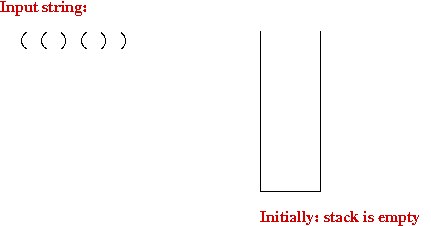
- After scanning the first character in the string:
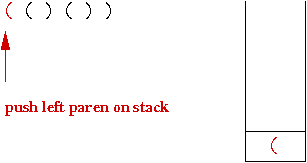
- The next char is another left paren:
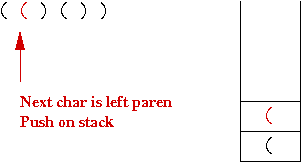
- The next char is a right paren that matches the second char:

- The next char is a left paren:
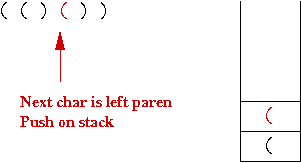
- The fifth char is a right paren that matches the fourth char:

- Finally, the last char is a right paren that matches the first char:
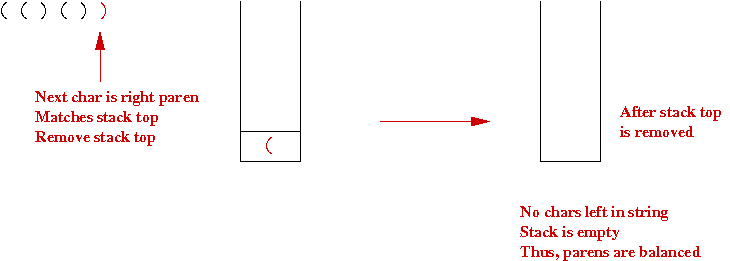
Here's the program:
(source file)
import java.util.*;
public class ParenBalancing {
public static void main (String[] argv)
{
// Test 1.
String s = "()(())()";
checkParens (s);
// Test 2.
s = "((())";
checkParens (s);
// Test 3.
s = ")(";
checkParens (s);
}
static void checkParens (String inputStr)
{
// Extract letters from String.
char[] letters = inputStr.toCharArray();
// We'll need a Character stack.
Stack<Character> stack = new Stack<Character> ();
boolean unbalanced = false;
for (int i=0; i<letters.length; i++) {
if (letters[i] == '(') {
// Push left paren.
stack.push (letters[i]);
}
else if (letters[i] == ')') {
// Right paren: we should have a match on the stack.
char ch = stack.pop ();
if (ch != '(') {
// Not a match.
unbalanced = true;
break;
}
}
} //end-for
if ( (unbalanced) || (! stack.isEmpty()) ) {
System.out.println ("String " + inputStr + " has unbalanced parens");
}
else {
System.out.println ("String " + inputStr + " has balanced parens");
}
}
}
Next, let's modify the above example to balance two types
of parentheses simultaneously:
- We'll assume the string contain only parentheses.
- Example: "([()])" (Balanced).
- Example: "((()]]" (Unbalanced).
Here's the program:
(source file)
import java.util.*;
public class ParenBalancing3 {
public static void main (String[] argv)
{
// Test 1.
String s = "([()])";
checkParens (s);
// Test 2.
s = "[][()]()";
checkParens (s);
// Test 3.
s = "((())]";
checkParens (s);
// Test 4.
s = "[)(]";
checkParens (s);
}
static void checkParens (String inputStr)
{
char[] letters = inputStr.toCharArray();
Stack<Character> stack = new Stack<Character> ();
boolean unbalanced = false;
for (int i=0; i<letters.length; i++) {
if ( (letters[i] == '(') || (letters[i] == '[') ) {
// Push every left paren of each kind.
stack.push (letters[i]);
}
else if (letters[i] == ')') {
// We should have a '(' match on the stack
char ch = ')';
if (! stack.isEmpty() ) {
ch = stack.pop ();
}
if (ch != '(') {
// Not matched => unbalanced.
unbalanced = true;
break;
}
}
else if (letters[i] == ']') {
// We should have a '[' match on the stack
char ch = ']';
if (! stack.isEmpty() ) {
ch = stack.pop ();
}
if (ch != '[') {
// Not matched.
unbalanced = true;
break;
}
}
} // end-for
if ( (unbalanced) || (! stack.isEmpty()) ) {
System.out.println ("String " + inputStr + " has unbalanced parens");
}
else {
System.out.println ("String " + inputStr + " has balanced parens");
}
}
}
Another stack application: palindromes
Yet another way to check if a string is a palindrome:
- Example: consider the string "kayak"
- First phase: push the letters from the first half:
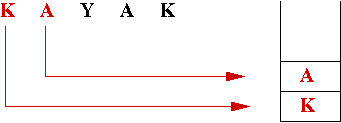
- Remove the middle character if word is of odd length:
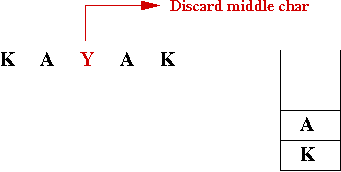
- Second phase: match latter half:

Let's examine the program:
(source file)
import java.util.*;
public class Palindrome {
public static void main (String[] argv)
{
// Test 1.
String str = "redder";
System.out.println ( str + " " + checkPalindrome(str) );
// Test 2.
str = "river";
System.out.println ( str + " " + checkPalindrome(str) );
// Test 3.
str = "neveroddoreven";
System.out.println ( str + " " + checkPalindrome(str) );
}
static String checkPalindrome (String str)
{
// Extract the letters.
char[] letters = str.toCharArray ();
// Create an empty stack.
Stack<Character> stack = new Stack<Character>();
// The letters must "balance" up to the middle.
int mid = letters.length / 2;
// Push the first half.
for (int i=0; i<mid; i++) {
stack.push (letters[i]);
}
// Odd or even? We have to adjust the mid-point accordingly.
if (letters.length % 2 > 0) {
// Odd number => swallow middle letter.
mid = mid+1;
}
// Now check the second half.
for (int i=mid; i<letters.length; i++) {
char ch = stack.pop ();
if (ch != letters[i]) {
// Mismatch => not a palindrome.
return "is not a palindrome";
}
}
return "is a palindrome";
}
}
Note:
- For a string of even length, the two characters at the middle
have to be checked against each other
=>
the two d's in redder
- For a string of odd length, we need to ignore the middle letter
=>
Ignore the v in civic
Building our own stack
Let's build our own stack data structure:
- We'll do this for char's
=>
Use it for the paren-balancing application.
- We'll use a simple array to hold the stack.
Sample code:
public class OurStack {
char[] letters; // Store the chars in here.
int top; // letters[top]: next available space.
// Constructor.
public OurStack ()
{
letters = new char [100];
top = 0;
}
public void push (char ch)
{
// Note: what if top >= letters.length?
letters[top] = ch;
top ++;
}
public char pop ()
{
// Note: what if top < 0?
top --;
return letters[top];
}
public boolean isEmpty ()
{
if (top == 0) {
return true;
}
else {
return false;
}
}
}
Let's improve this stack with some error checking:
(source file)
public class OurStack {
char[] letters; // Store the chars in here.
int top; // letters[top]: next available space.
// Constructor.
public OurStack ()
{
letters = new char [100];
top = 0;
}
public void push (char ch)
{
// Test for full stack.
if (top >= letters.length) {
System.out.println ("ERROR: OurStack.push(): stack overflow");
return;
}
letters[top] = ch;
top ++;
}
public char pop ()
{
// Test for empty stack.
if (top <= 0) {
System.out.println ("ERROR in OurStack.pop(): stack empty");
// Still need to have a return statement, so we return some "junk letter".
return '@';
}
top --;
return letters[top];
}
public boolean isEmpty ()
{
if (top == 0) {
return true;
}
else {
return false;
}
}
}
Note:
- The error recovery from pop() is a little
artificial
=>
We are still forced to return something.
- In the Supplement, we
describe how to use exceptions as a better way to handle errors.
- The stack above can be used in our paren-balancing
application:
(source file)
import java.util.*;
public class OurStackExample {
public static void main (String[] argv)
{
String s = "((()))";
checkParens (s);
s = "((())";
checkParens (s);
}
static void checkParens (String inputStr)
{
char[] letters = inputStr.toCharArray();
OurStack stack = new OurStack ();
// ... code similar to earlier examples ...
}
}
Next, let's use a linked-list instead of an array:
(source file)
import java.util.*;
public class OurStack3 {
// Use a linked list instead of an array.
LinkedList<Character> list;
public OurStack3 ()
{
// Can be unlimited in size now.
list = new LinkedList<Character>();
}
public void push (char ch)
{
// No need to check for upper limit.
list.add (ch);
}
public char pop ()
{
if (! list.isEmpty()) {
return list.removeLast();
}
else {
System.out.println ("ERROR in OurStack.pop(): stack empty");
return '@';
}
}
public boolean isEmpty ()
{
return list.isEmpty();
}
}
Note:
- The code is a little cleaner:
- We don't have to keep track of the "top" since the list
size is exactly the stack size.
- We can exploit list methods such as isEmpty().
- The stack grows only as much as necessary.
ADT's
What's an ADT?
- ADT = Abstract Data Type
- There are many senses in which this term is used
=>
We'll examine these below.
First meaning of ADT: a "standard" data structure with "well-known"
operations:
- Example: stack with operations push,
pop, isEmpty.
- Example: list with operations add,
search, get(i).
- What's important here are the meanings of the operations.
- It's clear that the list operations are different
from the stack operations.
Second meaning of ADT: the idea that implementations are hidden
- We can implement a stack using an array, a list or use some other
internal workings.
- The internal workings shouldn't change the behavior of
the operations as seen by users of the operations.
- The internal workings could be changed without affecting
the use of the ADT by others.
- Suppose our main() method uses a stack.
- Suppose the stack is really implemented with an array.
- If we changed the stack code so that it uses a linked-list,
then we shouldn't have to change any code in main.
Third meaning of ADT: language features that support ADT's
- Language feature: separate implementations in separate classes
(and files).
- Language feature: Use interface's in Java.
Let's look at an example of using interfaces.
- First, we'll re-write our balanced-parens example as:
(source file)
public class ParenBalancing5 {
public static void main (String[] argv)
{
String s = "()(())()";
// Use this stack implementation for the first example.
StackImpl1 stack1 = new StackImpl1 ();
ParenCheckTool.check (s, stack1);
s = "((())";
// Use another stack implementation for the second example.
StackImpl2 stack2 = new StackImpl2 ();
ParenCheckTool.check (s, stack2);
}
}
Note:
- We've put the real checking code in another class
=>
We call the method check() in that class.
- We also create a stack and pass that on to check().
- So, what's in the class ParenCheckTool?
(source file)
public class ParenCheckTool {
// NOTE: checkParens() is written to accept an interface instead
// of an actual class.
static void check (String inputStr, OurStackInterface stack)
{
// This code below is complete unchanged from before ...
char[] letters = inputStr.toCharArray();
boolean unbalanced = false;
for (int i=0; i < letters.length; i++) {
if (letters[i] == '(') {
stack.push (letters[i]);
}
else if (letters[i] == ')') {
// We should have a match on the stack.
char ch = ')';
if (! stack.isEmpty() ) {
ch = stack.pop ();
}
if (ch != '(') {
// Mismatch => unbalanced.
unbalanced = true;
break;
}
}
}
if ( (unbalanced) || (! stack.isEmpty()) ) {
System.out.println ("String " + inputStr + " has unbalanced parens");
}
else {
System.out.println ("String " + inputStr + " has balanced parens");
}
}
}
- Next, examine the file OurStackInterface.java:
(source file)
public interface OurStackInterface {
// Signature, and only the signature, of the push() method:
public void push (char ch);
// Same for the pop() method:
public char pop ();
// Same for the isEmpty() method:
public boolean isEmpty ();
}
Note:
- An interface has only method signatures, no code.
- An interface is really a specification.
- Whichever class implements the interface must have
bodies for the methods in the interface.
- Next, let's look at the first implementation:
(source file)
public class StackImpl1 implements OurStackInterface {
// An array implementation ...
char[] letters; // Store the chars in here.
int top; // letters[top]: next available space.
// ... the rest of the code is the same as in OurStack.java ...
}
- Similarly, here's the second one:
(source file)
import java.util.*;
public class StackImpl2 implements OurStackInterface {
// Use a linked list instead of an array.
LinkedList<Character> list;
// ... rest of the code is the same as OurStack3.java ...
}
- What's important to note:
- Suppose the class ParenCheckTool is compiled.
- Years later, we could change the code in the implementations
and in ParenBalancing5:
public class ParenBalancing5 {
public static void main (String[] argv)
{
String s = "()(())()";
// Use this stack implementation for the first example.
StackImpl3 stack3 = new StackImpl3 ();
ParenCheckTool.check (s, stack3);
s = "((())";
// Use another stack implementation for the second example.
StackImpl2 stack2 = new StackImpl2 ();
ParenCheckTool.check (s, stack2);
}
}
- We would not have to re-compile ParenCheckTool
=>
This is a key feature of Object-Oriented Programming (OOP).
Queues
What is a queue?
- A queue is a list.
- When you add something to the queue, you add it to the end
of the list.
- When you remove something from the queue, you remove it
from the front of the list.
The most basic Queue ADT has three operations:
- add: add an element to the end of the list.
- remove: remove an element from the front of the list.
- isEmpty: see if the queue is empty.
A more powerful queue might also implement methods like:
- get(i): get the i-th element in the queue.
- size: how many elements are in the queue?
Consider this example of a queue that uses Java's
LinkedList to serve as our queue data structure:
(source file)
import java.util.*;
public class QueueExample {
public static void main (String[] argv)
{
// We'll use Java's LinkedList as our queue.
LinkedList<String> taskQueue = new LinkedList<String>();
// Add some strings.
taskQueue.add ("Pay bills");
taskQueue.add ("Clean room");
taskQueue.add ("Do homework");
taskQueue.add ("See movie");
taskQueue.add ("Hang out");
// Now extract in "queue" order using the removeFirst() method in LinkedList.
System.out.println (taskQueue.removeFirst());
System.out.println (taskQueue.removeFirst());
System.out.println (taskQueue.removeFirst());
System.out.println (taskQueue.removeFirst());
System.out.println (taskQueue.removeFirst());
System.out.println ("=> Tasks remaining: " + taskQueue.size());
}
}
Note:
- Because Java's LinkedList is used for other purposes
(as a linked list!), it has a few variations of "remove" methods.
- The method removeFirst() is what we need for the
queue's remove operation.
Queue example: a strange card game
Consider the following two-person card game:
- There are N cards numbered 0, ..., N-1.
- Each player is dealt M cards from a shuffled deck.
- Each player is required to keep their pile of cards face down
=>
Players can't see the cards they haven't played yet.
- There is a common pile, initially empty, onto which
players will add their cards.
- At every turn, each player "plays" by taking the card
on top of their own pile and placing that in the common pile.
- The cards are revealed when "played" on to the common pile.
- If, in one turn, any one player's card exceeds the other's card by
by more than 2, then that player gets to keep all the cards in the
common pile.
- For example, if player 2 plays "7" and player 1 plays "3",
then player 2 scoops up the common pile and adds it to the bottom of
their own pile.
- The first player to have no cards remaining loses.
We will write a program to simulate the card game:
- We'll use a queue for each player's pile.
- We'll use a queue for the common pile.
Here's the program:
(source file)
// This card game is a variation of the War card game described
// in the book "Object-Oriented Data Structures Using Java" by
// N.Dale, D.T.Joyce and C.Weems.
import java.util.*;
public class StrangeCardGame {
public static void main (String[] argv)
{
// Use cards numbered 0,..,9 and deal 5 cards to each player.
playGame (5, 10);
}
static void playGame (int dealSize, int numCards)
{
// Cards dealt out to player 1:
LinkedList<Integer> player1 = new LinkedList<Integer>();
// Cards dealt out to player 2:
LinkedList<Integer> player2 = new LinkedList<Integer>();
// The pile between the two players:
LinkedList<Integer> pile = new LinkedList<Integer>();
// Make the cards and shuffle them randomly.
int[] cards = new int [numCards];
for (int i=0; i<cards.length; i++) {
cards[i] = i;
}
shuffle (cards);
// Deal cards to each player.
int cardCount = 0;
for (int k=0; k<dealSize; k++) {
player1.add (cards[cardCount]);
player2.add (cards[cardCount+1]);
cardCount += 2; // Note: += operator.
}
// Now play.
boolean done = false;
int round = 0;
while (! done) {
// Each player plays their first card.
int player1first = player1.removeFirst ();
pile.add (player1first);
int player2first = player2.removeFirst ();
pile.add (player2first);
System.out.println ("Round 0: player1's card=" + player1first + " player2's card=" + player2first);
if (player1first > player2first+2) {
// Add pile into player 1's cards.
addListToList (pile, player1);
System.out.println (" => player1 gets pile");
}
else if (player2first > player1first+2) {
// Add pile into player 2's cards.
addListToList (pile, player2);
System.out.println (" => player2 gets pile");
}
else {
System.out.println (" => both cards added to pile");
}
if (player1.isEmpty()) {
System.out.println ("Player 2 wins!");
done = true;
}
else if (player2.isEmpty()) {
System.out.println ("Player 1 wins!");
done = true;
}
} //end-while
}
static void shuffle (int[] A)
{
// ... random permutation ...
}
static void addListToList (LinkedList<Integer> list1, LinkedList<Integer> list2)
{
// ... Extract every item in list1 and add them to list2 ...
}
}
Note:
- The queue's above are queues of Integer's.
- There are three queues: one each for the two players, and
one for the common pile.
- The queue operations used are: add(), removeFirst()
and isEmpty().
A GUI application
Consider the following simple animation:
Here's the program
(source file)
// Various import's needed for GUI's.
import java.awt.*;
import java.awt.event.*;
import javax.swing.*;
import javax.swing.event.*;
import java.util.*; // This we need for LinkedList.
class AntEaterPanel extends JPanel {
// We'll put all the ant-clicks into a queue, from which the anteater
// will pull out the next target.
LinkedList<Point> antQueue = new LinkedList<Point>();
Point antEater; // The current position of the anteater.
Point nextAnt; // The position of the current ant being chased.
// Constructor.
public AntEaterPanel ()
{
// Listen to mouseclicks.
this.addMouseListener (
new MouseAdapter () {
public void mouseClicked (MouseEvent e)
{
handleClick (e.getX(), e.getY());
}
}
);
// The anteater will run in a separate thread.
Thread t = new Thread () {
public void run ()
{
move ();
}
};
t.start ();
}
public void paintComponent (Graphics g)
{
super.paintComponent (g);
// Clear drawing area.
g.setColor (Color.white);
Dimension D = this.getSize();
g.fillRect (0,0, D.width, D.height);
// Draw the ants.
g.setColor (Color.gray);
if (nextAnt != null) {
g.fillOval (nextAnt.x-2,nextAnt.y-2, 4, 4);
}
for (Iterator<Point> iter=antQueue.iterator(); iter.hasNext(); ) {
Point p = iter.next();
g.fillOval (p.x-2,p.y-2, 4, 4);
}
// AntEater.
g.setColor (Color.red);
g.fillOval (antEater.x-10,antEater.y-10, 20, 20);
}
void draw ()
{
// Place a call to paintComponent().
this.repaint ();
}
void handleClick (int x, int y)
{
// Add a new ant to the queue.
antQueue.add (new Point(x,y));
draw ();
}
void move ()
{
// This is where we'll start the anteater.
antEater = new Point (0,0);
while (true) {
// Anteater sleeps 100 milliseconds.
try {
Thread.sleep (100);
}
catch (InterruptedException e) {
}
if (nextAnt == null) {
if (! antQueue.isEmpty() ) {
// See if there's an ant to chase.
nextAnt = antQueue.removeFirst();
}
}
else {
if ( distance(nextAnt, antEater) < 10 ) {
// Eat the ant.
nextAnt = null;
}
else {
// Otherwise, step towards ant.
double theta = Math.atan2 ((nextAnt.y - antEater.y), (nextAnt.x - antEater.x));
double stepsize = 10.0;
antEater.x = (int) (antEater.x + stepsize*Math.cos(theta));
antEater.y = (int) (antEater.y + stepsize*Math.sin(theta));
draw ();
}
}
}
}
double distance (Point p, Point q)
{
double distSq = (p.x-q.x)*(p.x-q.x) + (p.y-q.y)*(p.y-q.y);
return Math.sqrt (distSq);
}
} //end-panel
class AntEaterFrame extends JFrame {
public AntEaterFrame ()
{
this.setTitle ("AntEater");
this.setSize (300, 300);
// The frame only consists of the panel.
AntEaterPanel panel = new AntEaterPanel ();
this.getContentPane().add (panel);
this.setVisible (true);
}
} //end-frame
public class AntEater {
public static void main (String[] argv)
{
AntEaterFrame f = new AntEaterFrame ();
}
}
Note:
- Let's point out a few things from the GUI code:
- There are three parts to it: main(), the frame
(AntEaterFrame) and the drawing area (AntEaterPanel).
- main() is very simple: we merely create an instance
of the frame.
- The frame too is quite simple: we set the size, place an
instance of the panel inside and make it visible.
- All the work is done inside the panel.
- To draw on the panel, we need to extend Java's
JPanel class to override the paintComponent() method.
=>
This is what is called for drawing to occur.
=>
It's where we put our drawing code.
- The panel also listens for mouseclicks, which are placed in
the queue.
- The panel also has the "logic" (anteater movement).
- Let's focus on the use of a queue:
- Each click creates a new ant, which is placed in the queue
(the add() operation).
- Once the anteater eats an ant, we look at the queue for the
next ant (the removeFirst() operation).
- We also need to test whether the queue is empty.









